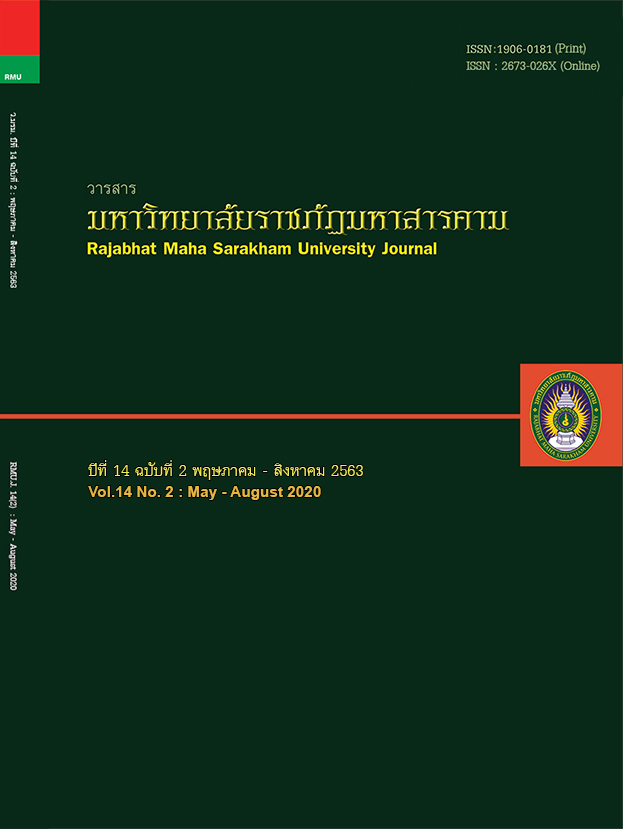Technique for Construction of a Regular Pentagon and Golden star : using a Golden Rectangle and Triangle
Main Article Content
Abstract
Geometry is principally constructed by only compass and straightedge (i.e. ruler). In addition, Gauss, who is 1 of the top three world-class mathematicians, has discovered the theory of the construction of a regular polygon that has an amount of the edge in prime number. This regular polygon can be built when the amount of edge is f(n) = , where n is number in the arithmetic order starting from 0 and added one by one. For example, n = 0 is a construction of equilateral triangle, while n = 1 and n = 2 are construction of regular pentagon and hexagon, respectively.
This article emphasisonly an alternative technique for the construction of a regular pentagon, which differs from the traditional construction explained in some treatises. Starting from, building up the golden rectangle and using a golden ratio of 1.618:1. The base of the golden triangle will be built from the wide side of the golden rectangle. Then 36° top corner of the golden triangle will be used to construct 108° interior corner of a regular pentagon, which the length of an edge is equal to the width of the golden rectangle resulting in an overlapping golden star created. This technique will easily encourage remembrance of the construction process, and an understanding of the length of an edge and interior corner of the regular pentagon.
Article Details
1. All articles undergo a thorough with at least three reviewers evaluating their suitability within the respective field of study, during the double-blind review.
2. The views expressed by individual authors do not represent the official views of the Editorial Boards of RMUJ: The author of each articie is responsible for all its contents.
3. The Editorial Boards do not reserve the copyrights. but proper citations need to be made.
References
บุญธรรม ภัทราจารุกุล. (2556). เขียนแบบเทคนิคเบื้องต้น. กรุงเทพฯ: ซีเอ็ดยูเคชั่น.
สถาบันส่งเสริมการสอนวิทยาศาสตร์และเทคโนโลยี กระทรวงศึกษาธิการ. (2559). หนังสือเรียนสาระการเรียนรู้พื้นฐานคณิตศาสตร์ เล่ม 1ชั้นมัธยมศึกษาปีที่ 1. กรุงเทพฯ: โรงพิมพ์สกสค. ลาดพร้าว.
สถาบันส่งเสริมการสอนวิทยาศาสตร์และเทคโนโลยี กระทรวงศึกษาธิการ. (2561). หนังสือเรียนสาระการเรียนรู้พื้นฐานคณิตศาสตร์ เล่ม 2 ชั้นมัธยมศึกษาปีที่ 1. กรุงเทพฯ: โรงพิมพ์ สกสค. ลาดพร้าว.
สถาบันส่งเสริมการสอนวิทยาศาสตร์และเทคโนโลยี กระทรวงศึกษาธิการ. (2551). หนังสือเรียนสาระการเรียนรู้พื้นฐานคณิตศาสตร์ เล่ม 2 ชั้นมัธยมศึกษาปีที่ 3. กรุงเทพฯ: โรงพิมพ์สกสค. ลาดพร้าว.
สถาบันส่งเสริมการสอนวิทยาศาสตร์และเทคโนโลยี กระทรวงศึกษาธิการ. (2547). หนังสือเรียนสาระการเรียนรู้เพิ่มเติมคณิตศาสตร์ เล่ม 1 ชั้นมัธยมศึกษาปีที่ 2. กรุงเทพฯ: โรงพิมพ์คุรุสภาลาดพร้าว.
สมนึก ภัททิยธนี. (2553). คณิตศาสตร์ชั้นมัธยมศึกษาปีที่ 2.กาฬสินธุ์: ประสานการพิมพ์.
สมนึก ภัททิยธนี. (2555). คณิตศาสตร์ชั้นมัธยมศึกษาปีที่ 3.กาฬสินธุ์: ประสานการพิมพ์.

